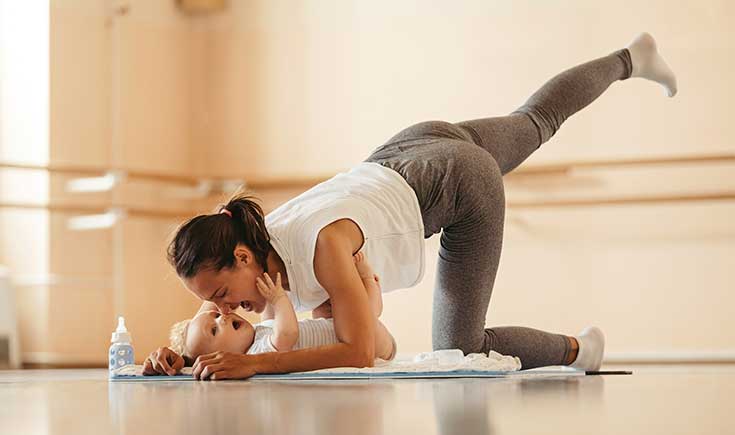

The initial first few weeks after having your bub is like a whirlwind, full of excitement and sleep deprivation. You have a newfound love, but also some newfound aches and pains, as your body slowly adjusts to this new stage of motherhood.
Considering the colossal journey your body has gone through over the past 9 months, it should come as no surprise that your body needs time to rest and heal before we can even begin to ask it to start performing the tasks we used to do pre pregnancy. Getting the green light from your doctor at your 6-8 week check-up doesn’t mean you can go full steam ahead at the gym, as there are a many different things to consider before returning to exercise.
What is happening to your body?
Your body is recovering fast and you should let it. The uterus will begin to shrink minutes after the baby is born, initially to facilitate the separation of the placenta from the uterine wall, but it will continue to contract until it withdraws into the pelvis about two weeks after delivery. By about four weeks post-partum, it will have returned to its pre-pregnancy size and weight, although your tummy may take several weeks (or months) after delivery to return to its pre-pregnancy size, depending on your weight gain and abdominal strength during pregnancy.
Weight loss after pregnancy will obviously depend on the weight gain during pregnancy, along with your level of fitness. As a rough guideline, your body weight should have increased by about 20% – 25% over the course of your pregnancy.
Factors effecting returning to exercise
- How you birthed your baby – caesarean births require a longer recovery time as you are recovering from major abdominal surgery. It is imperative that you allow enough time for your body to heal before undertaking anything other than gentle, measured movement. 10-12 weeks is often considered the correct amout of time.
- You may have health complications after the birth which dictates a longer recovery time.
- Emotionally, you may not feel up to exercising yet. Although exercise plays a key role in elevating your mood, you may feel exhausted and somewhat emotionally fragile.
- Although it is safe to exercise whilst breastfeeding, you may want to ensure that breastfeeding is properly established before starting to exercise again.
- The opinion of your doctor and/or midwife is key. They will be able to advise you on when you can resume exercise.
Rest
Apart from the obvious stress on the body during childbirth, adapting to being a mother can lead to fatigue and exhaustion. Dealing with the baby’s sleeping patterns and the influx of visitors in the first few weeks after birth can put great strain on the mum.
Rest and recuperation for at least two full weeks after childbirth is essential, longer if your baby was delivered by caesarean section. Gentle walking after those first two weeks should be fine until you are ready to embark on your postnatal recovery program, hopefully at around six weeks post-partum.
It is believed that your body will do the majority of its healing in the first 6 weeks, so this is why it is important to implement some gentle pelvic floor and internal core work during this time. Often this rehab gets placed at the very bottom of most mums’ priority lists when dealing with the overriding awareness that they’re now completely responsible for keeping their new bundle of joy alive. However, if this rehab doesn’t start after the initial 6 weeks, then making a full recovery can take months, rather than weeks.
Other factors to consider
Other factors that may delay your return to exercise after giving birth include, but are not limited to:
- Vaginal bleeding. Can still occur up to 6 weeks after birth
- Stitching and unhealed perineum. Often the mothers’ perineum can be torn during child birth.
- Inactivity for the last 8 weeks or so.
- Anaemia, due to loss of blood, can leave low levels of iron which can lead to fatigue.
Implications of exercise
You may notice issues relating to urinary incontinence, especially in the early months postpartum, as your pelvic floor will have been stressed by the latter stages of pregnancy and the delivery (especially if it was a vaginal delivery). You should continue to exercise the pelvic floor muscles as a regular part of your daily routine, ideally up to four times a day.
It is imperative that even once you have had clearance from your medical professional, you start your exercise regime slowly to take account of how your body adjusts. It may be that you resume a more ‘normal’ routine fairly quickly, but each mother is entirely different in that respect. Only you can truly decide how you are feeling by listening to your body.























